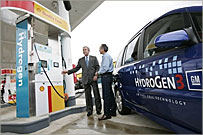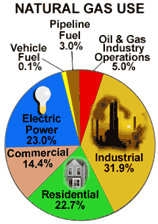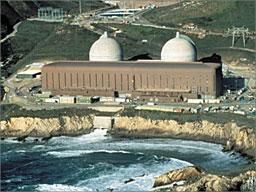
- Afghanistan
- Africa
- Budget Management
- Defense
- Economy
- Education
- Energy
- Environment
- Global Diplomacy
- Health Care
- Homeland Security
- Immigration
- International Trade
- Iraq
- Judicial Nominations
- Middle East
- National Security
- Veterans
- President's Cabinet
- USA Freedom Corps
- Faith-Based & Community Initiatives
- Office of Management and Budget
- National Security Council
- USA.gov
|
Home >
State of the Union
|

- President's Letter
- The President’s Energy Vision
- Changing the Way We Fuel Our Vehicles
- Changing The Way We Power Our Homes And Businesses
- Building On Our Past Progress
President's Letter
My fellow Americans,
Keeping America competitive requires reliable, affordable, and clean supplies of energy. Over the past five years, my Administration has taken steps to increase the domestic supply of energy, including alternative and renewable sources. We have also worked to improve energy efficiency and to make our energy infrastructure more secure and reliable. We implemented a new National Energy Policy, and last summer I signed into law the Energy Policy Act of 2005, the first comprehensive energy bill in more than a decade.
America’s energy challenges require continued action. For the sake of our economic and national security, we must reduce our dependence on foreign sources of energy – including on the natural gas that is a source of electricity for many American homes and the crude oil that supplies gasoline for our cars. To achieve this objective, we will take advantage of technology. My Advanced Energy Initiative provides for a 22-percent increase in funding for clean-energy technology research at the Department of Energy. To change how we power our homes and offices, we will invest more in zero-emission coal-fired plants, revolutionary solar and wind technologies, and clean, safe nuclear energy. To change how we power our automobiles, we will increase our research in better batteries for hybrid and electric cars and in pollution-free cars that run on hydrogen. We will also fund additional research in cutting-edge methods of producing ethanol, not just from corn, but from wood chips, stalks, or switch grass.
Applying the talent and innovative spirit of our citizens, we will foster economic growth, protect and improve our environment, move beyond a petroleum-based economy, and make our dependence on foreign sources of energy a thing of the past.
GEORGE W. BUSH
THE WHITE HOUSE
February 20, 2006
The President’s Energy Vision
President Bush believes the power of technology and the innovative spirit of America will reduce our reliance on foreign sources of energy, which will help ensure a growing and prosperous America in the 21st Century. We have both the technology and the know-how to meet the principal energy challenges we face: promoting energy conservation, repairing and modernizing our energy infrastructure, and increasing our energy supplies in ways that protect and improve the environment. Meeting each of these challenges is critical to expanding our economy, satisfying the energy needs of a growing population, and raising our standard of living.
A sound energy policy is also vital to national security and protecting the environment. We currently spend more than half a billion dollars a day on imported oil. We are increasingly concerned about the vulnerability of the electricity grid and pipeline systems to both unintentional and intentional disruptions. We are also focused on the environmental consequences of energy production, including emissions of air pollutants and greenhouse gases, primarily from the burning of coal, oil, and natural gas.
Since 2001, the Administration has spent nearly $10 billion to develop cleaner, cheaper, and more reliable alternative energy sources. As a result, America is on the verge of breakthroughs in advanced energy technologies that could transform the way we produce and use energy. To build on this progress, the President’s Advanced Energy Initiative provides for a 22% increase in funding for clean-energy technology research at the Department of Energy in two vital areas:
1. Changing the way we fuel our vehicles. We can improve our energy security through greater use of technologies that reduce oil use by improving efficiency, expansion of alternative fuels from homegrown biomass, and development of fuel cells that use hydrogen from domestic feedstocks.
2. Changing the way we power our homes and businesses. We can address high costs of natural gas and electricity by generating more electricity from clean coal, advanced nuclear power, and renewable resources such as solar and wind.
Just as our current challenges did not arise overnight, neither will the solutions to these challenges. We must make a sustained commitment to addressing the fundamental causes of high and volatile energy prices, while protecting our national security and the environment. Through the Advanced Energy Initiative, we can take new, bold steps towards the goal of a reliable, affordable, and clean energy future for all Americans.
Back to TopChanging the Way We Fuel Our Vehicles
Crude oil is used to produce a wide array of petroleum products, including gasoline, diesel and jet fuels, heating oil, lubricants, asphalt, plastics, and many other products. Not surprisingly, crude oil markets are monitored closely by consumers, businesses, and governments, because the prices of petroleum-based products depend heavily on the price of crude oil.
The transportation sector receives nearly all of its energy from petroleum products and accounts for two-thirds of U.S. petroleum use, mainly in the form of gasoline and diesel fuel. The Energy Information Administration (EIA) projects that consumption of gasoline and diesel fuel will continue to rise because the expected increase in total miles traveled will outweigh improvements in the efficiency of fuel use per mile traveled. This is projected to lead to a one-third increase in imports of crude oil and a near-doubling in imports of refined products over the next 25 years, such that these imports would account for 62.5% of our total oil use by 2030.
Advanced Energy Initiative Goals – Fueling Our Vehicles
Develop advanced battery technologies that allow a plug-in hybrid-electric vehicle to have a 40-mile range operating solely on battery charge.
Foster the breakthrough technologies needed to make cellulosic ethanol cost-competitive with corn-based ethanol by 2012.
Accelerate progress towards the President’s goal of enabling large numbers of Americans to choose hydrogen fuel cell vehicles by 2020.
In 2004, the U.S. consumed 20.7 million barrels of crude oil and refined products per day, approximately 58 percent of which were imported from other countries. About half of these imports come from non-OPEC nations, such as Canada and Mexico, while the other half come from OPEC nations, mainly Saudi Arabia, Venezuela, Nigeria, and Iraq. Oil supply disruptions pose a threat to our economy and national security, and that threat rises the more dependent we are on oil imports, particularly from less stable regions of the world.
Over the past two years, world oil prices have increased significantly relative to historical levels. Crude oil prices, which hovered in the $15-25 per barrel range from the mid-1980s until 2002, have been above $40 since February 2005. Many of the same factors that drove world oil markets during this time, such as low spare world-oil-production capacity and rapid world-oil-demand growth, will continue to affect markets in the near term. Other factors, such as geopolitical instability and weather, are also important but less predictable.
To reduce America’s vulnerability to oil supply disruptions, and the associated economic hardship for our Nation’s families and businesses, we must reduce our dependence on foreign sources of oil. This means increasing domestic production of oil here at home and expanding capacity to refine crude oil into products that consumers demand. It also means accelerating deployment of efficient hybrid and clean diesel vehicles in the near-term, developing domestic renewable alternatives to gasoline and diesel fuels in the mid-term, and investing in the advanced battery and hydrogen fuel-cell technologies needed for substantial long-term reductions in oil demand.
Employing Existing Technologies
Consistent with the President’s National Energy Policy and the energy bill signed into law last summer, the Administration has taken a number of steps to employ new technologies to improve the efficiency of our oil use and develop alternative fuels to displace oil.
Vehicle fuel economy. The Administration increased CAFE standards for light trucks and SUVs for the first time in a decade, raising the standard from 20.7 mpg to 22.2 mpg for the current model year 2007 vehicles. We have proposed additional increases in the fuel economy of light trucks and SUVs produced in model years 2008-2011, which would save 10 billion gallons of fuel over the lifetime of those vehicles.
Tax incentives for efficient vehicles. The President proposed, and Congress enacted, tax incentives of up to $3,400 per vehicle to encourage purchase of highly efficient hybrid and clean diesel vehicles, which offer near-term potential to reduce demand for fuels made from crude oil.
Clean diesel regulations. The Administration finalized rules that regulate emissions from both highway and non-road diesel engines and fuels, reducing emissions of sulfur and nitrogen oxides by more than 90%. Diesels offer 25-30% fuel efficiency advantage over current gasoline-engine technology, without the “black puff of smoke” of earlier versions.
Renewable ethanol and biodiesel. The energy bill signed by the President last summer established a renewable fuels standard to require the use of 7.5 billion gallons of ethanol and biodiesel by 2012, and extended tax benefits enabling both fuels to compete in today’s market.
Alternative fuel facilities. The energy bill also provides a 30% tax credit for installation of alternative fuel stations, up to a maximum of $30,000 per year. Currently only 556 public “E85” (85% ethanol) fueling stations exist in the U.S, and many more will be needed to increase the use of renewable fuels above the 10% that can be blended into conventional gasoline.
Hydrogen vehicles. In his 2003 State of the Union Address, President Bush announced a $1.2 billion Hydrogen Fuel Initiative aimed at developing the technology for commercially viable hydrogen-powered fuel cells to power cars, trucks, homes, and businesses with no pollution or greenhouse gases.
The effects of these actions are already being seen in today’s marketplace. For example, in 2005 sales of hybrid vehicles exceeded 200,000 for the first time ever, based in part on tax incentives for their purchase. And ethanol production capacity increased from 3.4 billion gallons in 2004 to 4.4 billion gallons today, with another 2.1 billion gallons of capacity currently under construction.
Accelerating Future Technologies
To significantly improve our future energy security, we must do more to reduce our future demand for oil and refined gasoline and diesel fuels. The President’s Advanced Energy Initiative proposes significant new investments and policies in three promising areas: (1) advanced batteries; (2) cellulosic ethanol; and (3) hydrogen vehicles.
1. Advanced Batteries
Accelerated consumer adoption of hybrid-electric vehicles offers the potential to significantly reduce oil consumption in the near-term. Further gains are possible with a “plug-in hybrid vehicle”: a hybrid-electric vehicle that can run either on electricity from its own batteries or on gasoline. Unlike current hybrid vehicles, which can use only the gasoline engine to charge the on-board battery, a plug-in hybrid can be plugged into a common household electrical outlet to recharge its batteries. This allows a consumer to drive as an electric vehicle for the majority of driving that takes place within 40 miles of home. For longer trips, the gasoline engine kicks in, and the vehicle drives like a regular hybrid-electric vehicle. As a result, fuel efficiency of plug-in hybrids could exceed 80 or more miles per gallon, particularly when the hybrids are driven in urban areas. Plug-in hybrids would generally be charged at night, when electric utilities have spare generating capacity available.
 Current battery technologies used in today's hybrid-electric vehicles store only enough energy to drive the vehicle in an electric-only mode at low speed for a very short range (1-2 miles). Simply adding additional batteries is not practical – according to some estimates, each hybrid-electric vehicle battery adds an additional $2,000 to $4,000 to the price of the hybrid-electric vehicle. To address these issues, advanced battery technologies such as “lithium-ion” batteries, similar to batteries used in cellular phones and other consumer electronics, can be adapted for vehicle use. These batteries, coupled with the development of advanced electric-drive technologies, will enable the commercialization of plug-in hybrids that can deliver the desired range.
Current battery technologies used in today's hybrid-electric vehicles store only enough energy to drive the vehicle in an electric-only mode at low speed for a very short range (1-2 miles). Simply adding additional batteries is not practical – according to some estimates, each hybrid-electric vehicle battery adds an additional $2,000 to $4,000 to the price of the hybrid-electric vehicle. To address these issues, advanced battery technologies such as “lithium-ion” batteries, similar to batteries used in cellular phones and other consumer electronics, can be adapted for vehicle use. These batteries, coupled with the development of advanced electric-drive technologies, will enable the commercialization of plug-in hybrids that can deliver the desired range.
To help bring down the cost of these highly-efficient vehicles, the President’s 2007 Budget includes $31 million in new research funding to support advanced battery research, a 27% increase over 2006 levels. In addition to the gasoline savings they make possible, plug-in hybrids represent a practical step toward hydrogen fuel-cell vehicles, which have some of the same electric-drive and power-management technologies. Through the large-scale replacement of gasoline with electricity and hydrogen produced from clean coal, nuclear, and renewable technologies, we could dramatically reduce future oil use, balance-of-payment deficits, and emissions of air pollutants and greenhouse gases.
2. Cellulosic Ethanol
Transportation fuels derived from biomass can be produced either by the conversion of sugar or starch crops to ethanol, or by conversion of soybean or other plant oils to produce biodiesel. These clean-burning fuels are currently mixed with gasoline or diesel fuel in small amounts (up to 10% for ethanol and up to 20% for biodiesel) and used in conventional vehicles to help reduce petroleum demand.
 The 3.4 billion gallons of ethanol blended into gasoline in 2004 amounted to about 2% by volume of all gasoline sold in the United States. Greater quantities of ethanol are expected to be used as a motor fuel in the future, in part due to two federal policies: an excise tax exemption of $0.51 per gallon of ethanol used as motor fuel, and a new requirement for at least 7.5 billion gallons of renewable fuel to be used in gasoline by 2012 (included in the recently passed Energy Policy Act).
The 3.4 billion gallons of ethanol blended into gasoline in 2004 amounted to about 2% by volume of all gasoline sold in the United States. Greater quantities of ethanol are expected to be used as a motor fuel in the future, in part due to two federal policies: an excise tax exemption of $0.51 per gallon of ethanol used as motor fuel, and a new requirement for at least 7.5 billion gallons of renewable fuel to be used in gasoline by 2012 (included in the recently passed Energy Policy Act).
Virtually all domestically produced ethanol currently comes from corn. However, corn and other starches and sugars are only a small fraction of biomass that can be used to make ethanol. A recent DOE/USDA study suggests that, with aggressive technology developments, biofuels could supply some 60 billion gallons per year – 30% of current U.S. gasoline consumption – in an environmentally responsible manner without affecting future food production.
To achieve greater use of “homegrown” renewable fuels, we will need advanced technologies that will allow competitively priced ethanol to be made from cellulosic biomass, such as agricultural and forestry residues, material in municipal solid waste, trees, and grasses. Advanced technology can break those cellulosic materials down into their component sugars and then ferment them to make fuel ethanol.
To help reduce the costs of producing these advanced biofuels, and ready these technologies for commercialization, the President’s 2007 Budget increases DOE’s biomass research funding by 65%, to a total of $150 million. The President’s goal is to make cellulosic ethanol cost-competitive with corn-based ethanol by 2012, enabling greater use of this alternative fuel to help reduce future U.S. oil consumption.
3. Hydrogen Vehicles
In his 2003 State of the Union Address, President Bush announced a $1.2 billion Hydrogen Fuel Initiative to reverse America's growing dependence on foreign oil by developing the technology for commercially viable hydrogen-powered fuel cells to power cars, trucks, homes, and businesses with no pollution or greenhouse gases.
Through partnerships with the private sector, the Hydrogen Fuel Initiative and related FreedomCAR activities seek to make it practical and cost-effective for large numbers of Americans to use clean, hydrogen fuel-cell vehicles by 2020. Since hydrogen can be made from domestic fossil, nuclear and renewable energy resources, this will dramatically improve America's energy security by significantly reducing the need for oil, as well as help clean our air and reduce greenhouse gas emissions.
 To continue our progress towards reducing oil consumption, the President’s 2007 Budget increases funding for hydrogen technology research by $46 million over current levels. Under the President’s FreedomCAR program, the Department of Energy is conducting research in partnership with industry to make today’s hybrid-electric vehicle components more affordable. These components are also needed for tomorrow’s hydrogen vehicles. Although we have made significant strides in reducing the high volume cost of a fuel cell by more than half, further innovations are necessary to make this technology cost-competitive. We also need to develop improved materials and methods that will allow for economic and effective hydrogen storage in vehicles and at refueling stations. A significant fraction of the hydrogen funding added by the President’s budget will be used for basic research in materials science to address this fundamental challenge. Finally, we are working with industry to develop technology to enable safe production and delivery of hydrogen.
To continue our progress towards reducing oil consumption, the President’s 2007 Budget increases funding for hydrogen technology research by $46 million over current levels. Under the President’s FreedomCAR program, the Department of Energy is conducting research in partnership with industry to make today’s hybrid-electric vehicle components more affordable. These components are also needed for tomorrow’s hydrogen vehicles. Although we have made significant strides in reducing the high volume cost of a fuel cell by more than half, further innovations are necessary to make this technology cost-competitive. We also need to develop improved materials and methods that will allow for economic and effective hydrogen storage in vehicles and at refueling stations. A significant fraction of the hydrogen funding added by the President’s budget will be used for basic research in materials science to address this fundamental challenge. Finally, we are working with industry to develop technology to enable safe production and delivery of hydrogen.
The promise of hydrogen technology is too great to ignore. The Department of Energy estimates that, if hydrogen reaches its full potential, the Hydrogen Fuel Initiative and FreedomCAR program could reduce our oil demand by over 11 million barrels per day by 2040 – approximately the same amount of crude oil America imports today.
Back to TopChanging The Way We Power Our Homes And Businesses
 Natural gas has numerous uses in homes, industry, commerce, electricity production, and transportation and is a vital component of fertilizer and chemical production. In 2004, the United States consumed 61 billion cubic feet of natural gas per day, primarily for industrial applications, residential use, and electric generation. At present, 85% of U.S. natural gas demand is met through domestic production; the remainder is met largely through transport by pipeline from Canada, with an increasing amount arriving by tanker in the form of liquefied natural gas (LNG) from Trinidad, Algeria, and other countries.
Natural gas has numerous uses in homes, industry, commerce, electricity production, and transportation and is a vital component of fertilizer and chemical production. In 2004, the United States consumed 61 billion cubic feet of natural gas per day, primarily for industrial applications, residential use, and electric generation. At present, 85% of U.S. natural gas demand is met through domestic production; the remainder is met largely through transport by pipeline from Canada, with an increasing amount arriving by tanker in the form of liquefied natural gas (LNG) from Trinidad, Algeria, and other countries.
U.S. natural gas consumption is projected to grow to 74 billion cubic feet per day by 2025. Over the past decade, natural gas has been the “fuel of choice” for new natural gas combined-cycle power plants. Compared to coal-fired power plants, natural gas power plants emit less air pollution and cost less to build. As a result, demand for natural gas in the power sector has increased steadily over the past 15 years, even in the face of dramatically higher prices.
Wholesale natural gas prices at Henry Hub on the Louisiana Gulf coast (a common natural gas pricing benchmark) averaged around $2-$3 per thousand cubic feet from 1994 through the middle of 2000. Prices then spiked to a peak of $10.50 per thousand cubic feet in December of 2000 in response to an unusually cold winter and low hydroelectric production in the West before falling back to their previous low levels. Over the past four years, natural gas prices increased substantially from roughly $3 per thousand cubic feet in early 2002 to over $8 per thousand cubic feet recently, with a pronounced price spike due to Hurricanes Katrina and Rita. At present, natural gas prices track high crude oil prices because natural gas is often used as a substitute for oil in power production and heating. Furthermore, the tight balance between supply and demand has led to a more volatile market, which can respond dramatically to weather events and geopolitical developments.
Advanced Energy Initiative Goals – Powering Our Homes and Businesses
Complete the President’s commitment to $2 billion in clean coal technology research funding, and move the resulting innovations into the marketplace.
Develop a new Global Nuclear Energy Partnership (GNEP) to address spent nuclear fuel, eliminate proliferation risks, and expand the promise of clean, reliable, and affordable nuclear energy.
Reduce the cost of solar photovoltaic technologies so that they become cost-competitive by 2015, and expand access to wind energy through technology.
This substantial increase in natural gas prices and volatility has had a negative impact on the U.S. industrial sector. High prices for natural gas translate to increased production costs for U.S. companies, which places them at a disadvantage to their foreign competitors. As a result, many firms have either shut down U.S. production facilities altogether or relocated them to another country where energy costs are more competitive with the global market. According to the National Association of Manufacturers, the chemicals and plastics industries, which rely on natural gas both for energy and as a raw material, have lost 250,000 jobs and $65 billion in business because of rising natural gas prices. High natural gas prices similarly harm the competitiveness of U.S. farm products in global markets, as natural gas is a primary input for fertilizer.
Diversification of our electric power sector will ensure the availability of affordable electricity and ample natural gas supplies. At the same time, increased efficiency will help reduce demand for natural gas. By easing the demand pressure on natural gas, prices will drop and U.S. firms will be more competitive in the global market, keeping jobs here at home.
Employing Existing Technologies
Consistent with the President’s National Energy Policy and the energy bill signed into law last summer, the Administration has taken a number of steps to increase the supply of natural gas, improve efficiency, and develop alternatives to natural gas for electric power generation.
The Administration has provided new access to domestic natural gas supplies by streamlining its permitting processes, providing additional funding for processing of permit applications, and offering new lease sales in promising offshore areas.
At the President’s direction, Federal agencies are working to expedite permitting processes and accelerate development and expansion of U.S. liquefied natural gas (LNG) terminals, which should improve natural gas availability and reduce prices.
The energy bill set first-time energy efficiency standards for 14 large appliances and raised existing standards for others. These standards will help reduce the need for “peaking” power provided from natural gas.
In the absence of Congressional action on the Clear Skies Initiative, the Bush Administration finalized two regulations: the Clean Air Interstate Rule (CAIR) and the Clean Air Mercury Rule (CAMR). Together these two rules create a similar program to control air pollution from the power sector and foster investments in newer, cleaner coal technologies.
The energy bill also provided several new programs to encourage investments in safe and reliable nuclear power: production tax incentives and “risk insurance” intended to cover costs of unforeseen legal or regulatory challenges to plant operation. Nuclear energy provides reliable and clean power.
Finally, the energy bill contained $3.4 billion over 10 years in tax incentives to encourage the production of electricity using renewable wind, solar, biomass, and geothermal energy sources, including the first-ever tax credit for residential solar energy systems.
The effects of high natural gas prices are already being seen in today’s marketplace. The percentage of new power plants fueled by natural gas has declined from more than 90% when President Bush took office to 64% today. Thanks in part to Administration policies, only 31% of new power plants projected to be built by 2025 will use natural gas. The Energy Information Administration also projects a near-doubling in non-hydro renewable energy capacity between now and 2025.
Accelerating Future Technologies
To enhance our future energy security, we can and must do more to reduce our future demand for natural gas and foster alternatives for power production. The President’s Advanced Energy Initiative proposes significant new investments and policies in three promising areas: (1) clean coal technology; (2) nuclear power; and (3) renewable solar and wind energy.
1. Clean Coal Technology
The U.S. holds more than one quarter of the world’s coal reserves, and the energy content of the Nation’s coal resources exceeds that of the world’s known recoverable oil. Coal is also the workhorse of the Nation’s electric power industry, supplying more than half the electricity consumed by Americans and serving as the cornerstone of America's central power system. To preserve this economically vital energy foundation, we must invest in innovative, low-cost environmental compliance technologies for existing plants and develop cleaner and more efficient technologies for use in new plants.
 During his 2000 campaign, the President committed to investing $2 billion over 10 years to fund research in clean coal technologies, a category of technologies that allows for the use of coal to generate electricity while meeting environmental regulations at low cost. This research and development program is pioneering more effective pollution controls for existing coal-fired power plants and an array of new technologies that would eliminate air and water pollutants from the next generation of power plants.
During his 2000 campaign, the President committed to investing $2 billion over 10 years to fund research in clean coal technologies, a category of technologies that allows for the use of coal to generate electricity while meeting environmental regulations at low cost. This research and development program is pioneering more effective pollution controls for existing coal-fired power plants and an array of new technologies that would eliminate air and water pollutants from the next generation of power plants.
To tap the potential of America’s enormous coal reserves, the President’s 2007 Budget includes $281 million in funding for the Coal Research Initiative, nearly completing the President’s $2 billion commitment 4 years early. This program includes $54 million for the FutureGen initiative, a public-private sector partnership to develop innovative technologies for a nearly emissions-free coal plant of the future that captures and stores the carbon dioxide it produces rather than releasing it into the atmosphere.
2. Nuclear Energy
 Nuclear power provides slightly more than one-fifth of the electricity that we use to power our factories, office buildings, homes, and schools. Over 100 operating nuclear power plants, located at 65 sites in 31 states, constitute the second-largest source of electricity generation in the country. The plants are, on average, 24 years old and are licensed to operate for 40 years with an option to renew for an additional 20 years.
Nuclear power provides slightly more than one-fifth of the electricity that we use to power our factories, office buildings, homes, and schools. Over 100 operating nuclear power plants, located at 65 sites in 31 states, constitute the second-largest source of electricity generation in the country. The plants are, on average, 24 years old and are licensed to operate for 40 years with an option to renew for an additional 20 years.
Nuclear power provides significant benefits to the Nation, in the form of cleaner air and low and stable electricity prices. Nuclear power does not emit the air pollutants and greenhouse gases that result from coal-fired and natural-gas-fired generation. Nuclear power is also domestic and provides energy security – North American uranium reserves are more than sufficient for the foreseeable future. Moreover, once constructed and paid for, nuclear power plants are relatively inexpensive to operate – 1.8 cents per kilowatt-hour (kWh) of electricity generated. This is slightly below the operating costs of a coal-fired power plant and well below natural-gas-fired generation at current prices.
Nuclear power also faces significant challenges. New nuclear power plants require more up-front capital expense than other plants of similar size and must go through a lengthy regulatory process, which has not been tested since Congress adopted this process in 1992. The energy bill attempts to address these problems through a package of financial incentives (including Federal “risk insurance”) intended to reduce the risk of an investment in a new nuclear plant. However, management of spent nuclear fuel remains an issue, both with respect to the risk it could be stolen or diverted for potential misuse and with respect to its ultimate disposition.
To enable a bright future for nuclear power, both in the United States and around the world, the President’s 2007 Budget contains $250 million for the Global Nuclear Energy Partnership (GNEP). Under this partnership, America will work with nations like France, the United Kingdom, Japan, and Russia that have advanced civilian nuclear energy programs. Together, we will develop and deploy innovative, advanced reactors and new methods to recycle spent nuclear fuel. This will allow us to produce more energy, while dramatically reducing waste and eliminating many of the nuclear byproducts that could be used to make weapons.
As these technologies are developed, we will work with our partners to provide developing countries with small-scale reactors that would be secure, cost-effective, and able to meet their energy needs, as well as related nuclear services that would ensure that they have reliable fuel supply. In exchange, these countries would agree to use nuclear power only for electricity – and forgo uranium enrichment and reprocessing activities that can be used to develop nuclear weapons. By working with other nations under the Global Nuclear Energy Partnership, we can provide safe, cheap, and reliable energy that growing economies need – while reducing the risk of nuclear proliferation.
GNEP also will help resolve nuclear waste disposal issues. Based on technological advancements that would be made through GNEP, the volume and radio-toxicity of waste requiring permanent disposal at Yucca Mountain could be greatly reduced, eliminating the need for an additional repository. It is important to emphasize, however, that GNEP does not diminish in any way the need for, or the urgency of, the nuclear waste disposal program at Yucca Mountain. Yucca Mountain is still required under any fuel cycle scenario.
3. Renewable Solar and Wind Energy
Solar energy is clean, abundant, widespread, and renewable. Various technologies can capture this solar energy, concentrate it, store it, and convert it into other useful forms of  energy. Concentrating Solar Power (CSP) devices optically focus or concentrate the thermal energy of the sun to drive a generator or heat an engine. They do so by means of lenses or mirrors arranged in a trough or tower configuration. Solar water heating systems directly absorb the sun's radiation with specially-coated absorbers to heat air or water for use in a building. Solar water heaters can be used in large commercial applications or in low-profile installations on residences anywhere in the United States.
energy. Concentrating Solar Power (CSP) devices optically focus or concentrate the thermal energy of the sun to drive a generator or heat an engine. They do so by means of lenses or mirrors arranged in a trough or tower configuration. Solar water heating systems directly absorb the sun's radiation with specially-coated absorbers to heat air or water for use in a building. Solar water heaters can be used in large commercial applications or in low-profile installations on residences anywhere in the United States.
Photovoltaic (PV) devices generate electricity directly from sunlight via an electronic process that occurs naturally in certain types of material. Electrons in certain types of crystals are freed by solar energy and can be induced to travel through an electrical circuit, powering any type of electronic device or load. PV devices can be used to power small devices (e.g., road signs and calculators), homes, or even large stores or businesses. Worldwide growth rates for PV for the last 5 years have averaged well over 35%, meaning the amount of installed power doubles every 4 years or less. However, this rapid growth is from a very small base; PV still accounts for less than 1 percent of electricity generation worldwide. Emerging technologies, such as “solar shingles” where PV cells are embedded into roofing materials, offer the prospect of “zero-net energy homes,” which on average create as much energy as they consume.
To fulfill solar energy’s promise, the President’s 2007 Budget proposes a new $148 million Solar America Initiative – an increase of $65 million over FY06. The Solar America Initiative will accelerate the development of advanced photovoltaic materials that convert sunlight directly to electricity, with the goal of making solar PV cost-competitive with other forms of renewable electricity by 2015. As the per-unit cost for these advanced PV technologies falls, sales volume will go up, driving new innovation and further cost reductions. Globally, attempts to bring electricity to the developing world will frequently employ solar PV as the lowest-cost alternative.
 Wind energy is one of the world's fastest-growing energy technologies. In 2005, the U.S. wind energy industry installed more than 2,300 megawatts (MW) of new wind energy capacity – or over $3 billion worth of new generating equipment – in 22 states. Areas with good wind resources have the potential to supply up to 20% of the electricity consumption of the United States.
Wind energy is one of the world's fastest-growing energy technologies. In 2005, the U.S. wind energy industry installed more than 2,300 megawatts (MW) of new wind energy capacity – or over $3 billion worth of new generating equipment – in 22 states. Areas with good wind resources have the potential to supply up to 20% of the electricity consumption of the United States.
In response to a recommendation in the President’s 2001 National Energy Policy, the Bureau of Land Management (BLM) prepared a Programmatic Environmental Impact Statement (EIS) to evaluate issues associated with wind energy development on Western public lands (excluding Alaska) administered by the BLM. The EIS, which was finalized in late 2005, implements a Wind Energy Development Program within the Department of the Interior, establishes policies and best management practices for wind energy right-of-way authorizations, and amends 52 BLM land-use plans in Colorado, Idaho, Montana, Nevada, New Mexico, Oregon, Utah, Washington, and Wyoming to set aside areas of significant wind energy potential for further development.
To expand the generation of clean energy from wind, the President’s 2007 Budget includes $44 million for wind energy research – a $5 million increase over FY06 levels. This will help improve the efficiency and lower the costs of conventional wind turbine technologies; it will also help develop new small-scale wind technologies for use in low-speed wind environments. Combined with the ongoing efforts to expand access to Federal lands for wind energy development, this new funding will help dramatically increase the use of wind energy in the United States.
Back to TopBuilding On Our Past Progress
President Bush has placed a high priority on ensuring affordable, reliable, and clean sources of energy for America. In May 2001, he proposed his National Energy Policy, which included over 100 recommendations to increase domestic supplies of energy, encourage efficiency and conservation, invest in our energy infrastructure, and develop alternative and renewable sources of energy.& Over the past four years, the Bush Administration has worked to implement these recommendations and improve our Nation’s energy situation. In addition, last summer Congress passed the first comprehensive energy legislation in over a decade – the Energy Policy Act of 2005. This historic bill follows many of the principles outlined by President Bush to strengthen our Nation’s electrical infrastructure, reduce our dependence on foreign sources of energy, increase conservation, and expand the use of clean renewable energy.
However, several important elements of the President’s National Energy Policy remain to be addressed:
ANWR: The President continues to support Congressional action to authorize environmentally responsible oil and gas exploration within a small area of the Arctic National Wildlife Refuge (ANWR) located in northern Alaska. Using modern technologies and subject to the world’s most stringent environmental protections, ANWR could produce as much as 1 million barrels of oil per day to help meet our future energy needs. Opening ANWR will also create tens of thousands of new jobs for American workers.
Refineries: Due to consolidation in the refining industry and increased demand for gasoline and diesel fuels, U.S. refineries have operated at more than 90% capacity in recent years. This has strained the existing refinery system, particularly during times of unforeseen disruptions, and led to high and volatile fuel prices. The President has called for new investments in refinery capacity, either through expansions at existing sites, or through construction of new facilities on former military sites. The President has expressed his desire to work with Congress on legislation to help accomplish this, and believes that we should develop a one-year, EPA-led permitting process that can provide expedited decisions while maintaining high environmental standards for review.
New Source Review: The New Source Review (NSR) permitting program creates regulatory uncertainty because it is inflexible, its applicability requirements are confusing, and it can impose high costs due to delays in the permit process. Such discouragement results in lost capacity, as well as lost opportunities to improve energy efficiency and reduce air pollution. As called for by the President’s National Energy Policy, EPA has continued a vigorous program of NSR improvements designed to remove unnecessary regulatory barriers to modernization in the energy sector, thereby helping to address the extreme demands being placed on our Nation’s energy supply infrastructure. However, litigation has slowed the implementation of these rules. These rules should be adopted in legislation, so that private industry is encouraged to invest more quickly in upgrades that will make our energy sector more efficient and productive.
Offshore Oil and Gas: The Outer Continental Shelf (OCS) is a significant source of oil and gas for the Nation’s energy supply, providing more than 25 percent of the country’s natural gas production and more than 30 percent of total domestic oil production. Estimates of oil and gas resources in undiscovered fields on the OCS total 76 billion barrels of oil and 406 trillion cubic feet of gas. The President continues to support existing moratoria on OCS production where states do not wish such activity to occur off their immediate coasts. However, the President also supports increasing OCS production in cooperation with states that support such development.
Alaska Gas Pipeline: The North Slope of Alaska has an estimated 35 trillion cubic feet of natural gas, which is currently stranded due to the lack of a pipeline to transport it to market. At present, nearly all of the natural gas produced during oil production operations at Prudhoe Bay is reinjected and used to increase oil recovery. Approximately 3 billion cubic feet per day (equivalent to about 30% of current Gulf of Mexico production) could be brought to market through an Alaska natural gas pipeline. Although the Alaska Natural Gas Pipeline Act signed by the President in 2004 contained numerous incentives for the industry and the State of Alaska to reach agreement on those items needed to build the pipeline, no agreement has been reached yet. The President continues to encourage all parties to resolve remaining issues as soon as possible, so that stranded gas resources from Alaska can soon be brought to the Lower 48 states.
Clear Skies: To ensure that we meet growing demand for electricity while protecting the environment, the President has called on Congress to enact Clear Skies legislation to cut power plant pollution of sulfur dioxide, nitrogen oxides, and, for the first time, mercury by an unprecedented 70 percent. Clear Skies will significantly expand the Clean Air Act’s most innovative and successful program to further reduce emissions from more than 1300 power plants nationwide by as much as 9 million tons annually. Utilities will achieve these reductions by spending almost $50 billion on cutting-edge pollution abatement technology. Clear Skies will also help promote new investments in cleaner coal technologies.


